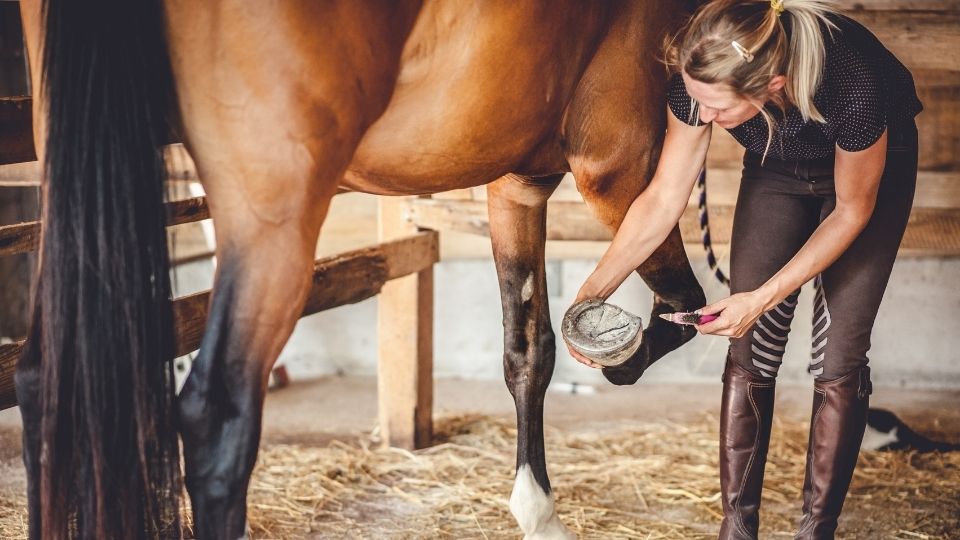
How Thick is a Horse Hoof? Essential Insights for Owners
Share
One question many health-conscious pet owners of horses often ponder is, 'how thick is a horse hoof'? Understanding the anatomy and health of a horse's hoof is crucial for proper care and maintenance. This article will provide a detailed look at horse hoof thickness, its significance in overall horse health, and how to care for your horses hooves effectively.
The horse hoof is a remarkable structure that serves multiple purposes, from supporting the horse's weight to absorbing shock during movement. The thickness of a horse hoof can vary significantly depending on several factors, including breed, age, health status, and environment. Typically, a healthy horse hoof can be expected to be between 1 to 2 inches thick, though variations are common.

The Anatomy of the Horse Hoof
Before diving deeper into hoof thickness, it's important to understand the basic anatomy of a hoof. The hoof consists of various parts, including:
- Wall: The outer layer that bears most of the horse's weight.
- Sole: The underside that protects the inner structures.
- Frog: A triangular rubbery structure that aids in shock absorption.
- Digital Cushion: Located above the frog, this structure also helps absorb shock.
Influencing Factors on Hoof Thickness
The thickness of a horse hoof can be influenced by various factors:
- Breed: Different breeds have distinctive hoof characteristics. Some breeds like Arabians typically have lighter and thinner hooves compared to Clydesdales, who often have thicker hooves.
- Age: Younger horses tend to have softer hooves, which can be thinner, while older horses may develop thicker hooves due to wear.
- Health Status: Horses with certain health issues may develop abnormalities in hoof thickness.
- Environment: Hard or rough terrain can lead to thicker hooves as they adapt to their surroundings.

Signs of Healthy Hoofs
As a responsible horse owner, it's vital to regularly check for signs of healthy hooves. Look for:
- Evenness: A healthy hoof should have an even thickness all around.
- Color: Bright color can indicate good health, while dullness might signal problems.
- Cleansing: Regular cleaning helps avoid dirt buildup that can lead to disease.
How Often to Trim Hooves?
The typical horse should have its hooves trimmed every 6 to 8 weeks. This keeps them from becoming overgrown and prevents cracks or other issues. It's best to consult with a farrier regularly to ensure your horse's hooves are in prime condition. For a more detailed guide to caring for horse hooves, you might find our article on wrapping horse hooves useful.

The Importance of Hoof Care
Hoof care is paramount for your horse's overall health. Poor hoof management can lead to discomfort and even lameness. A well-maintained hoof can:
- Enhance Performance: Healthy hooves contribute to higher performance in riding and racing.
- Prevent Injuries: Regular care prevents various conditions like thrush or laminitis.
- Boost Longevity: Good hoof health supports a longer, active life for your horse.
Common Hoof Problems and Solutions
Even with utmost care, horses can develop hoof issues. Common problems include:
- Thrush: A bacterial infection that can occur in the grooves of the frog. Regular cleaning can prevent this.
- Abscesses: These can form inside the hoof and lead to severe pain. Prompt veterinary attention is crucial.
- Laminits: A serious condition affecting the laminae within the hoof that can cause substantial discomfort.

Do Shoeing Options Matter?
Choosing whether to shoe your horse is another essential consideration regarding hoof health. Many owners opt for shoes, especially for those who are ridden regularly or compete. Shoes help:
- Provide Traction: Shoes can enhance grip on slippery surfaces.
- Protect Hoof from Wear: Regular work can wear down hooves and shoes can provide an extra layer of protection.
However, some horse owners prefer a natural approach, opting not to shoe their horse. This can be a viable option, but it often requires more frequent trimming and careful monitoring.
Conclusion
In conclusion, the answer to 'how thick is a horse hoof' is a complex subject with significant implications for horse health and overall well-being. A horse's hoof thickness can be influenced by many factors, and regular care is essential in maintaining its health. As a health-conscious pet owner, understanding the dynamics of hoof care can lead to a happier, healthier horse.
For further information on hoof care, including effective soaking methods, please check out our article on soaking horse hooves and learn about maintaining not only the hooves but the overall health of your beloved equine friend. Remember, your horse relies on you for their care, and understanding their needs goes a long way in ensuring their health and happiness.
As an Amazon Associate, I earn from qualifying purchases.
Frequently Asked Questions
1. What is the average thickness of a horse hoof?
The average thickness of a horse hoof ranges from 1 to 2 inches, but this can vary based on breed and other factors.
2. How can I maintain my horses hoof health?
Regular cleaning, trimming, and working with a farrier are essential to maintain hoof health. You might also consider learning about proper techniques, such as what happens if a horse loses a hoof.
3. When should I consult a vet about my horse's hooves?
If you notice any signs of lameness, unusual growth, or changes in your horses behavior, its advisable to consult your vet.
